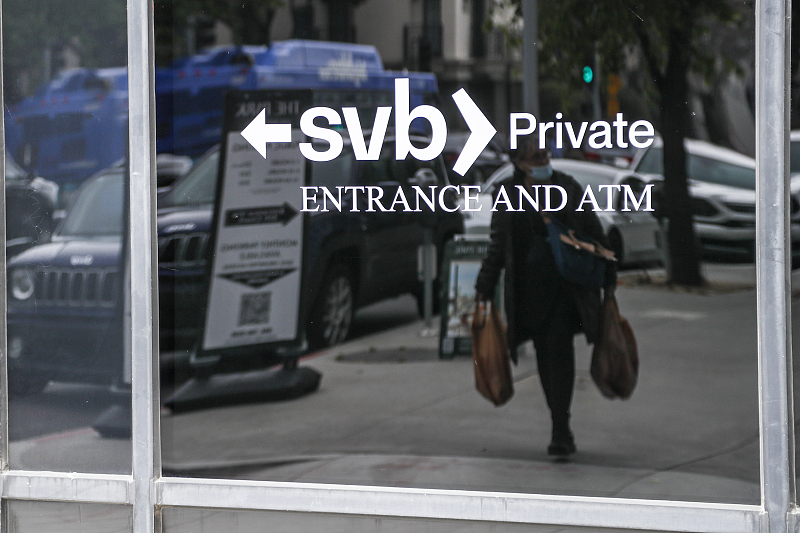
Silicon Valley Bank headquarters in Santa Clara, California, U.S., March 9, 2023. /CFP
Silicon Valley Bank headquarters in Santa Clara, California, U.S., March 9, 2023. /CFP
Editor's note: Xavier Vives, Professor of Economics and Finance at IESE Business School, is the co-author (with Darrell Duffie, Thierry Foucault, and Laura Veldkamp) of the report Technology and Finance. The article reflects the author's views and not necessarily those of CGTN.
Should the rest of the world be worried about the collapse of Silicon Valley Bank (SVB) last week? SVB was the 16th largest bank in the United States, with about $210 billion in assets and a market valuation of $44 billion at its peak. That makes this the second-largest U.S. bank failure (following Washington Mutual in 2008). Although SVB itself was not systemically important to the U.S. financial system, it could be a warning sign. This past weekend, regulators also shut down New York's Signature Bank, and banking-sector stocks tanked.
SVB catered primarily to start-ups and venture-capital funds, a rather narrow circle of depositors that quickly withdrew $42 billion – about one-quarter of the bank's deposits – at the first sign of trouble. The run came so suddenly that the Federal Deposit Insurance Corporation (FDIC) was forced to intervene during a weekend. Yet, given that 96 percent of SVB's deposits were uninsured, its clients had good reason to panic.
What happened? One might say that this was the unexpected outcome of an apparently prudent decision. The pandemic-era tech boom dramatically increased SVB's deposits, so it decided to invest a substantial share of that in U.S. Treasury and mortgage bonds. Although these yielded a low return, there was still a profit to be made, because ultra-low interest rates meant that SVB had basically no interest costs on its clients' deposits.
But then the U.S. Federal Reserve started hiking interest rates at an almost unprecedented pace, eroding SVB's margins. Forced to increase the margin that it was paying for deposits, it attempted to sell long-dated bonds and buy short-term bonds with better yields. But its bond portfolio was suddenly worth $15 billion less than its purchase price, and the bank had already taken a $1.8 billion loss selling bonds to meet withdrawal demands. Unable to raise additional capital, SVB's fate was sealed when rumors of trouble started on March 9 and major players recommended withdrawing deposits.
That brings us to the potentially systemic aspect of SVB's failure. Many other banks also have large portfolios of long-dated securities, implying heavy losses if sold before maturity, owing to the sharp increase in interest rates over the past year. According to the FDIC, more than $4 trillion has gone into deposits since April 2020, but only 10 percent of the total was used for lending, whereas about 50 percent went to purchase securities. Commercial banks were holding paper losses of up to $600 billion at the end of last year, and those losses may become real if the banks need to liquidate their positions.
The situation is especially worrisome for any smaller bank with a concentrated deposit base. SVB was particularly at risk because it had a high proportion of uninsured business deposits that were sensitive to interest-rate hikes. Moreover, its assets were not revalued as rates rose, it specialized in tech lending (demand for which was tanking), and its securities portfolio was not hedged with floating rates.

Exterior photos of Silicon Valley Bank located in Santa Monica, U.S., March 13, 2023. /CFP
Exterior photos of Silicon Valley Bank located in Santa Monica, U.S., March 13, 2023. /CFP
Since banks are much better capitalized (and have higher liquidity buffers) today than in the run-up to the 2008 global financial crisis, larger institutions should be able to weather the storm, especially now that U.S. regulators have rolled out a new backstop to guarantee deposits. But, as was the case in the 1980s savings and loan crisis, many smaller institutions with correlated strategies may still create a systemic problem. Since these institutions have not undergone any sort of proper stress test, owing to the repeal by the Trump administration of certain provisions of the Dodd-Frank Act, regulators will need to be on the lookout for new financial fragilities.
SVB's collapse also could have negative implications for the tech sector and innovation more broadly, given that it worked with around half of all U.S. tech and life-science VC firms. Here, the damage may be more severe, particularly at a time when the tech sector is feeling the consequences of higher interest rates. The United Kingdom's Chancellor of the Exchequer, Jeremy Hunt, has already warned that SVB's collapse poses a serious risk to tech and life-sciences companies, and the UK is now preparing to offer cash support to the sector.
Back in the U.S., Secretary of the Treasury Janet L. Yellen has long insisted that, after 2008, there must be no more bailouts for investors and owners. But bailing out uninsured business deposits to prevent a disruption to payroll services is another matter. Of course, even if bailing them out is well worth doing, it introduces the risk of moral hazard. U.S. President Joe Biden has stated that "whatever is needed" will be done to quell a systemic disruption.
It also points to a deeper tension in the conduct of monetary policy. Central banks' mission is to keep inflation under control and to maintain financial stability. By pursuing unprecedented interest-rate hikes within such a short space of time, they may have traded one imperative for the other. The higher interest rates will slow the economy, but they are also increasing debt burdens and leading to more business failures, which in turn will affect the solvency of lenders.
In addition to this indirect effect, the SVB case points to a more direct one. The increase in interest rates has induced valuation losses in bond portfolios, introducing new financial fragilities. If more banks are forced to liquidate their portfolios, they will incur heavy losses – as will central banks if, in the process of quantitative tightening, they sell their own stock of securities before maturity.
As every driver knows, braking hard in the middle of a curve is dangerous. But that seems to be what central banks have decided to do. The risk of an accident is growing. At least we have better airbags nowadays.
Copyright: Project Syndicate, 2023
(If you want to contribute and have specific expertise, please contact us at opinions@cgtn.com. Follow @thouse_opinions on Twitter to discover the latest commentaries in the CGTN Opinion Section.)